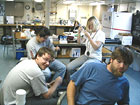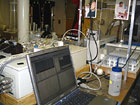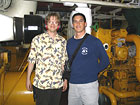

 | |||||||||||||
|
|
Journals 2005/2006Denis Costello
July 19, 2005 Our regular schedule of CTD sampling continued along the LP (La Push), OZ (Ozette), and CF (Cape Flattery) lines. I carried on with my usual work of sampling for chlorophyll, sampling nutrients and performing fluorometer readings. When I wasn't filtering, I helped the NOAA group macerate filters for domoic acid analysis. Using a long metal spatula, I had to tear up the filters into small pieces so domoic acid can be easily extracted by using a pipette. It is a long process and tiring on the hands, so the NOAA folks recruited as many people as possible to help with the task.
Julian was still trying to figure out what was wrong with the Lachat. He seems to think that it might be the filter in the Milli-Q water purification system. The Milli-Q system provides nano-pure water to the science labs. If this water is even slightly contaminated, it would cause the Lachat to not work properly. So he asked the science techs to change the filter and see what if any difference that would make.
After dinner, Sheryl, Stacey, Amy and I decided to take a tour of the ship's engine room. First Engineer Jim was nice enough to offer us the tour. We met in the computer lab at 6:30 pm where he handed us schematic diagrams of the control, electrical, generator and engine rooms. We had to wear ear protection because of the level of noise. There are six generators on the Atlantis with only three of them running at a time. The generators are responsible for all of the energy provided throughout the ship. I would describe this area as the heart of the vessel. We then made our way to the engine turbines. I expected the room to be very warm, but to my surprise it was cold. There was an air condition system present to keep the turbine room cold. I saw two of the three turbines on the ship. The third turbine is responsible for the bow thruster, which allows the ship to turn on its center of mass. The engine room is the place to call if there are any problems in the lab. Whether it would be a backed-up sink or taking water form the Milli-Q system, the engine room must be informed of what is happening. After the engine room tour, I reviewed the pictures and video that I had taken. I wrapped up my day by showing the footage to those that couldn't make the tour.
|
||||||||||||


